In your propagation/seeding house, you are setting the stage for the remainder of your growing season, and there are a few key things I would like to remind you about to minimize pest issues at this crucial stage.
- Cleanliness is key! Make sure you start with clean trays for any transplants you may be generating. If the materials are not new, be sure they are sterilized to prevent contamination of pests that may be lingering from their previous use.
- Water and nutrient management are essential. Proper moisture will promote germination and growth; too much or too little, and you are inviting pests and pathogens to the party.
- Keep vegetables and flowers segregated, especially if starting your own tomato transplants. Thrips (Figures 1 & 2), a key insect pest in greenhouses, love to move between these two crops and often carry the notorious Tomato spotted wilt virus (TSWV) with them. This virus may not be apparent in your flowers, but if it gets into your tomato crop and you are growing a susceptible variety, you will not have plants that reach the flowering stage, let alone set fruit.
- Monitor for early infestations of common greenhouse pests like thrips, aphids (Figure 3), whiteflies (Figure 4), and mites (Figure 5). These pests can kill young seedlings or spill over into the field if they are not managed in your transplant trays.
- Don’t waste your money on seed treatments if you are growing transplants. Neonicotinoid seed treatments protect direct-seeded crops that may come under attack from wireworms, cucumber beetles, or even seedcorn maggots. However, if you start your plants in the greenhouse and transplant them to the field, most of this protection will be gone by the time the plants reach the field. A better strategy for this type of systemic insecticide protection is to apply the products as a drench to the transplant trays just prior to planting in the field or as an in-field furrow application at transplant.
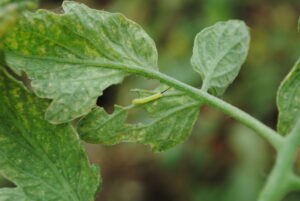
Figure 1. Thrips damage on a tomato leaf accompanied by an early instar of a tobacco hornworm. Photo by L. Ingwell.
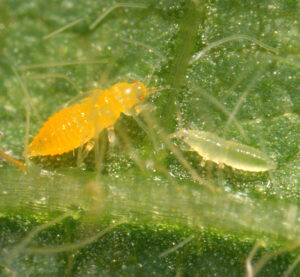
Figure 2. Thrips adult and nymph. Photo by J. Obermeyer.
What do you do if your preventative strategies fall down or fail and you notice pests on your transplants? Try to treat the problem before you take them out into the field. When the plants are concentrated in flats in the greenhouse, it is more effective to apply pesticides or biological agents for control and can lead to higher success. If you are experiencing issues with fungus gnats or thrips, using a soil-dwelling natural enemy can help reduce the population at the plant-soil interface. This would include applications of entomopathogenic nematodes (nematodes that eat insects, Figure 6) or the predatory mite Hypoaspis miles (also called Stratiolaelaps scimitus, Acarologists can’t make up their minds!).
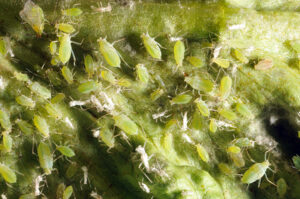
Figure 3. Aphids on the underside of lettuce leaves. Photo by J. Obermeyer.
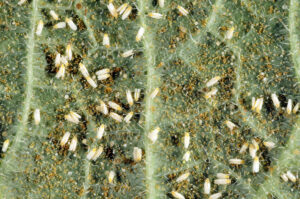
Figure 4. Whitefly eggs and adults on the underside of a cucumber leaf. Photo by J. Obermeyer.
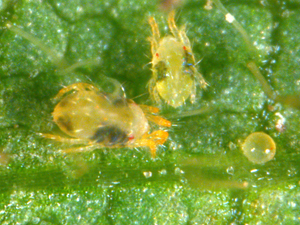
Figure 5. Twospotted spider mite adults and an egg on a cucumber leaf. Photo by J. Obermeyer.
This mite forages on the soil surface and feeds on small insects that inhabit this area, including the immature stages of thrips, fungus gnats, and springtails. You can release other natural enemies for the above-ground pests, depending on the target. This may include other predatory mite species, Orius insidiosus (Figure 7), parasitoid wasps, or the larval stages of lacewings (Figure 8).
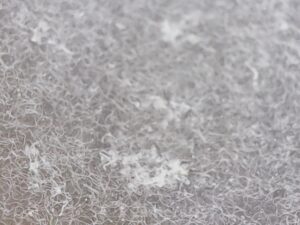
Figure 6. Entomopathogenic nematodes in water under the magnification of a dissecting microscope. Photo by L. Ingwell.
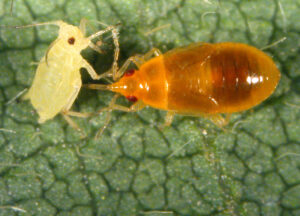
Figure 7. Orius insidiosus nymph feeding on an aphid. Photo by J. Obermeyer.
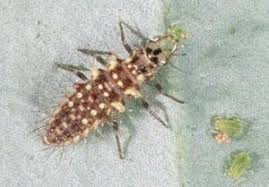
Figure 8. Lacewing larva feeding on aphids. Photo by J. Obermeyer.
Another option includes using foliar insecticides, conventional or biorational. Be sure to check the label for use in a greenhouse and see the Midwest Vegetable Production Guide for assistance with calculating rates for small-scale applications (mwveguide.org). For an updated list of suppliers of predators and parasitoids, visit this publication from Virginia Cooperative Extension: ENTO-480.
Starting with strong, pest-free transplants is the best strategy for heading into a productive 2023 growing season!